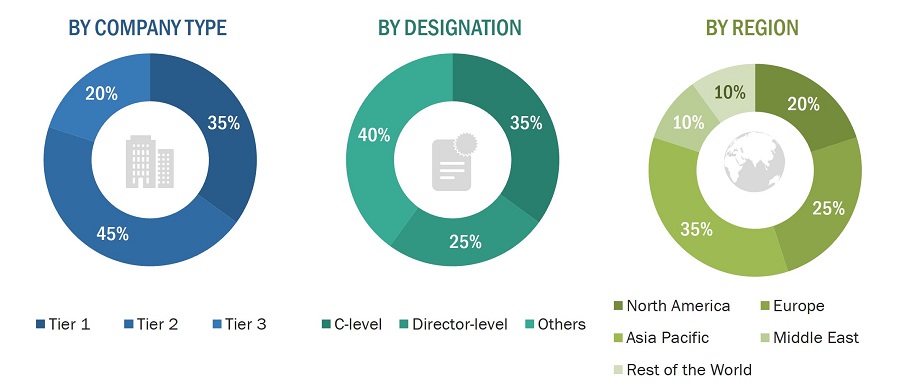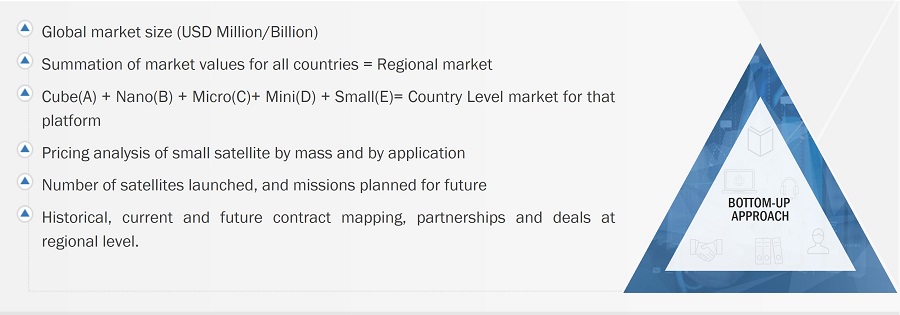The study involved four major activities in estimating the current size of the small satellite market. Exhaustive secondary research was done to collect information on the market, peer market, and parent market. The next step was to validate these findings, assumptions, and sizing with industry experts across the value chain through primary research. Both top-down and bottom-up approaches were employed to estimate the complete market size. After that, market breakdown and data triangulation were used to estimate the market size of segments and subsegments.
Secondary Research
The ranking analysis of companies in the small satellite market was carried out using secondary data from paid and unpaid sources, as well as by analyzing the product portfolios and service offerings of key companies operating in the market. These companies were rated based on the performance and quality of their products. These data points were further validated by primary sources.
Secondary sources referred for this research study included the European Space Agency (ESA), the National Aeronautics and Space Administration (NASA), the United Nations Conference on Trade and Development (UNCTAD), the Satellite Industry Association (SIA), corporate filings such as annual reports, investor presentations, and financial statements of trade, business, and professional associations. The secondary data was collected and analyzed to arrive at the overall size of the market, which was validated by primary respondents.
Primary Research
Extensive primary research was conducted after obtaining information regarding the small satellite market scenario through secondary research. Several primary interviews were conducted with market experts from both, the demand and supply sides across major countries of North America, Europe, Asia Pacific, the Middle East, and Rest of the World. Primary data was collected through questionnaires, emails, and telephonic interviews. The primary sources from the supply side included various industry experts, such as Chief X Officers (CXOs), Vice Presidents (VPs), Directors, from business development, marketing, product development/innovation teams, and related key executives from small satellite vendors; system integrators; component providers; distributors; and key opinion leaders.
Primary interviews were conducted to gather insights such as market statistics, data of revenue collected from the products and services, market breakdowns, market size estimations, market forecasting, and data triangulation. Primary research also helped in understanding the various trends related to technology, application, vertical, and region. Stakeholders from the demand side, such as CIOs, CTOs, and CSOs, and installation teams of the customer/end users who are using small satellite were interviewed to understand the buyer’s perspective on the suppliers, products, component providers, and their current usage of small satellite and future outlook of their business which will affect the overall market.

To know about the assumptions considered for the study, download the pdf brochure
Market Size Estimation
The research methodology used to estimate the size of the small satellite market includes the following details.
-
The top-down and bottom-up approaches were used to estimate and validate the size of the small satellite market. The research methodology used to estimate the market size includes the following details.
-
The key players were identified through secondary research, and their market ranking was determined through primary and secondary research. This included a study of the annual and financial reports of the top market players and extensive interviews of leaders, including chief executive officers (CEO), directors, and marketing executives.
-
All percentage shares, splits, and breakdowns were determined using secondary sources and verified through primary sources. All possible parameters that affect the markets covered in this research study were accounted for, viewed in extensive detail, verified through primary research, and analyzed to obtain the final quantitative and qualitative data. This data was consolidated, enhanced with detailed inputs, analyzed by MarketsandMarkets, and presented in this report.
Global small satellite market size: Bottom-Up Approach
The small satellite market, by application and mass, was used as a primary segment for estimating and projecting the global market size from 2024 to 2029.
The market size was calculated by adding the mass subsegments mentioned below, and the different methodologies adopted for each to arrive at the market numbers are delineated below:

Global small satellite market Size: Top-Down Approach
In the top-down approach, the overall market size was used to estimate the size of individual markets (mentioned in the market segmentation) acquired through percentage splits from secondary and primary research. The size of the immediate parent market was used to implement the top-down approach and calculate specific market segments. The bottom-up approach was also implemented to validate the revenues obtained for various market segments.
-
Companies manufacturing small satellites and their subsystems are included in the report.
-
The total revenue of these companies was identified through their annual reports and other authentic sources. In cases where annual reports were unavailable, the company revenue was estimated based on the number of employees, sources such as Factiva, ZoomInfo, press releases, and any publicly available data.
-
Company revenue was calculated based on their operating segments.
-
All publicly available company contracts related to small satellites were mapped and summed up.
-
Based on these parameters (contracts, agreements, partnerships, joint ventures, product matrix, secondary research), the share of small satellites in each segment was estimated.
Based on these parameters (contracts, agreements, partnerships, joint ventures, product matrix, secondary research), the share of small satellites in each segment was estimated

Data Triangulation
After arriving at the overall size of the small satellite market from the market size estimation process explained above, the total market was split into several segments and subsegments. The data triangulation and market breakdown procedures explained below were implemented, wherever applicable, to complete the overall market engineering process and arrive at the exact statistics for various segments and sub-segments of the market. The data was triangulated by studying various factors and trends from both the demand and supply sides. The market size was validated using both top-down and bottom-up approaches.
Market Definition
A small satellite, or smallsat, encompasses any satellite with a mass from approximately 1 to 1000 kilograms. These satellites are engineered to perform space missions similar to larger satellites but are constructed using smaller, lighter, and often commercially available components. The classification includes various subcategories like small, mini, micro, nano, and CubeSats, based on their mass. Small satellite typically leverages advancements in miniaturization of technology and are launched either independently or as secondary payloads, allowing for cost-effective access to space and opportunities for high-frequency mission updates and constellation deployment. These satellites are typically used by businesses and governments for a variety of applications including communication, earth observation, and scientific research.
Market Stakeholders
-
Satellite Component Manufacturers
-
Satellite Manufacturers
-
Satellite Integrators
-
Launch Service Providers
-
Government and Civil Organizations Related to the Market
-
Small Satellite Companies
-
Payload Suppliers
-
Scientific Institutions
-
Meteorological Organizations
-
Component Suppliers
-
Technologists
-
R&D Staff
Report Objectives
-
To define, describe, and forecast the size of the small satellite market based on mass, subsystem, end use, application, frequency, orbit, and region
-
To forecast the market size of segments with respect to various regions, including North America, Europe, Asia Pacific, Middle East, and Rest of the World along with major countries in each region
-
To identify and analyze key drivers, restraints, opportunities, and challenges influencing the growth of the small satellite market
-
To analyze technological advancements and product launches in the market
-
To strategically analyze micro markets, with respect to their growth trends, prospects, and their contribution to the market
-
To provide a detailed competitive landscape of the market and analyze competitive growth strategies such as new product developments, contracts, partnerships, joint ventures, agreements, and collaborations adopted by key players in the market
-
To identify the detailed financial position, key products, unique selling points, and key developments of leading companies in the market
-
To strategically profile key market players and comprehensively analyze their market ranking and core competencies.
Available Customizations:
MarketsAndMarkets offers the following customizations for this market report:
-
Additional country-level analysis of the small satellite market
-
Profiling of additional market players (up to 5)
Product Analysis
-
Product matrix, which provides a detailed comparison of the product portfolio of each company in the small satellite market



User
Feb, 2020
Hi Team, kindly provide market intelligence on commercial space transportation. Thanks.
User
Feb, 2020
Hi Team, Kindly provide intelligence on space platforms and products such as Göktürk-1, earth observation satellite, Göktürk-2 (launched 2012), earth observation satellite, Göktürk-3 satellite, Türksat 6A, communications satellite. Thanks, Turkish aerospace. .
Oliver
May, 2019
Looking into the current small satellite quantitative trend over the past few years (mainly micro/mini satellite size) and any future predictions..
Colon
Aug, 2019
VACCO builds small propulsion systems for several prime contractors. We are evaluating investing in additional B&L and M&E to support this product line and would like to understand how large is the market place, key suppliers, and timeline with the technology. Cgardner@vacco.com .
Guido
Apr, 2019
Looking to estimate the potential market for much lower-cost liquid propellant rocket engine; scalable across a wide range of thrusts for boost, sustain, orbital, and planetary ascent applications..